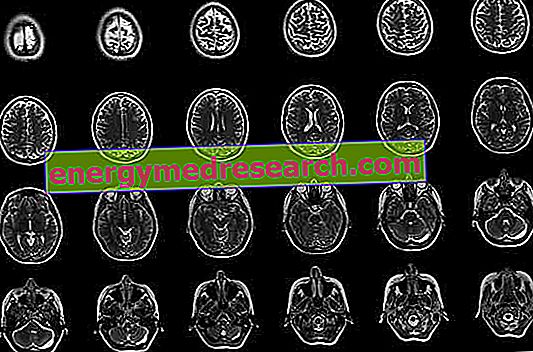Generality
Magnetic resonance with contrast is a highly sensitive and specific diagnostic test, capable of providing, with respect to conventional magnetic resonance, clearer and more detailed images of the internal structures of the human body (blood vessels, organs, tissues, etc.).
Sensitivity and specificity of the patient are assured of high sensitivity and specificity, it is the use of a contrast agent, which a medical staff member injects into the patient, intravenously, just before the diagnostic examination.
The most common contrast agent is based on gadolinium, a rare earth metal.

Thanks to contrast magnetic resonance, doctors are able to study in greater depth: tumors, the blood supply to an organ or tissue, blood flow in the arteries and veins, inflammatory processes and, finally, injuries to internal anatomical structures.
MRI with contrast is safe for most people.
The contraindications are different; among these, mention should be made of the presence of metallic components or devices within the body, severe renal failure, severe liver failure and pregnancy.
In general, the valuable results of an MRI with contrast are available within 3-4 days.
A brief review of what MRI is
Magnetic resonance, whose full name would be nuclear magnetic resonance, is a diagnostic test that allows the visualization of the inside of the human body, without resorting to surgical incisions or ionizing radiations, but thanks to harmless magnetic fields and equally harmless radio waves .
Virtually free of side effects and with very few contraindications, magnetic resonance imaging provides clear and detailed three-dimensional images of so-called soft tissues (nerves, muscles, ligaments, fat, blood vessels etc.) and of the so-called hard tissues (bones and cartilages). This makes it a test of absolute relevance in many fields of medicine: from traumatology to oncology, passing through orthopedics, gastroenterology, cardiology, etc.
The only limit of magnetic resonance is the high cost of the equipment, necessary for the creation of magnetic fields for the observation of the human body, and the maintenance costs of the aforementioned equipment.
What is contrast magnetic resonance?
Magnetic resonance with contrast is a particular type of nuclear magnetic resonance, which involves the use of a contrast medium, injected into the patient intravenously, in order to obtain even clearer and more detailed images of the internal structures of the human body (in particular, blood vessels, organs and tissues of various kinds).
In essence, it is a more sensitive and more specific nuclear magnetic resonance than conventional nuclear magnetic resonance.
Performable in the best equipped hospitals and radiological clinics, magnetic resonance with contrast is one of the minimally invasive diagnostic tests ; this is due precisely to the peculiarity of this technique: the intravenous injection of the contrast medium, a substance capable, in some subjects, of causing adverse reactions and more.
Equally any other type of magnetic resonance, contrast magnetic resonance imaging is a radiology practice and the reading of its results is the responsibility of a radiologist, a doctor specializing in radiology.

Contrast: what is it and what are the main types?
There are different contrast media that can be used for a magnetic resonance with contrast.
The most well-known and used contrast media are those based on gadolinium, a rare-earth metal dissolved in an aqueous solution .
Among the least used and known, we note those based on iron oxide and those based on manganese .
The choice of the contrast medium to be used is up to the radiologist and depends mainly on which organ or tissue will be investigated during the examination.
uses
The greater sensitivity and greater specificity of magnetic resonance with contrast allow us to study in detail:
- Inflammatory processes affecting organs, tissues, joints, muscles, bones, etc .;
- Tumors;
- The state of health of arterial and venous blood vessels, and the flow of blood within them ( angio-magnetic resonance );
- Blood circulation of organs and tissues;
- Injuries to organs or tissues.
Very often, magnetic resonance imaging with contrast is an in-depth examination, following a conventional magnetic resonance that proved to be not exhaustive.
In which parts of the body can it be located?
The parts of the body most subject of investigation of the contrast magnetic resonance examinations are: the head, the thorax, the abdomen, the pelvis and the vertebral column.
The use of magnetic resonance with contrast for the observation of important joints, such as the knee, or parts of the body, such as hands or feet, is very rare, however possible.
Preparation
In preparation for contrast MRI, the patient must:
- Complete with the primary care physician a specific questionnaire, the purpose of which is to ascertain whether or not there are contraindications to the examination, and to take it with you on the day of the examination, to show it to the medical staff;
- Perform a blood creatinine test ( creatininemia ) near the MRI with contrast (not before 30 days) and take the results with you on the day of the exam, to show them to the medical staff immediately after the above questionnaire;
- Observe a complete fast in the last 6 hours before the exam. If for example the procedure is held in the morning, the last meal must be that of the previous evening;
- Shortly before the examination, deprive yourself of any garment or object containing metal parts (ex: necklaces, shoes, earrings, bags, etc.) and inform the medical staff if you suffer from claustrophobia and, in the case of a female patient, if you are in a state of pregnancy (or suspected).
Procedure
After having deprived himself of any object and clothing with metal parts and having answered the last pre-exam questions, the patient must lie down, in a supine position, on a suitable sliding bed, which will be used to put him inside the diagnostic equipment. Generally, the equipment for nuclear magnetic resonance is a restricted cylindrical structure, capable of containing an individual only and in a relaxed position.
To guide and assist the patient during the accommodation on the couch, he is a radiology technician, who, immediately afterwards, also provides him with all possible comforts (eg: pillows, blankets, earplugs, etc.) and gives him the last fundamental instructions for the correct conduct of the exam. Among these indispensable instructions, the absolute immobility to which the patient must adhere during the entire procedure deserves a mention: the body's movements, in fact, jeopardize the accuracy of the images, hence the success of the open MRI.
At this point, the radiologist doctor intervenes, who, in collaboration with a professional nurse, takes care of performing the intravenous injection of the contrast fluid .
Once the contrast medium has been injected, exposure to magnetic fields and radio waves, or the actual diagnostic examination, can finally begin.

Figure: contrast media injector
It should be remembered that modern magnetic resonance equipment is equipped with loudspeakers and cameras for communicating with medical personnel, who, generally, once the procedure has begun, takes place in a room adjacent to where the patient resides
. The presence of a communication system guarantees complete control of the situation and the possibility, to those who are submitting to the procedure, to report any problems or problems.
As a conventional MRI, even magnetic resonance with contrast is noisy. This explains why, at the beginning of the exam, the patient receives the aforementioned ear plugs.
Where does the injection of the contrast agent take place and how long does it last?
Normally, injection of the contrast medium takes place in a vein in the arm, using a syringe, and has a duration of between 10 and 30 seconds .
How long does the contrast agent take?
Once injected, the contrast medium is ready for its diagnostic function within a few minutes .
What feelings does the patient feel at the time of injection?
For most patients, injection of contrast medium is painless and does not cause any particular malaise; for a minority of patients, on the other hand, it is associated with temporary sensations / disorders, such as: chills, nausea, headache and / or vomiting.
How long does the contrast medium remain in circulation?
The human body takes less than 24 hours to completely eliminate the contrast medium.
The main route of elimination is urine.
The most consistent effects of the contrast agent are in place in the first hours following the injection; after which we witness their gradual attenuation.
How long can a magnetic resonance with contrast last?
The magnetic resonance with contrast is longer than the conventional magnetic resonance, as it also includes the injection procedure of the contrast medium.
Depending on the part of the body being investigated, a magnetic resonance with contrast can last between 25 and 65 minutes .
What happens at the end of the exam?
Once the magnetic resonance with contrast is finished, a person in charge of the medical staff helps the patient to get off the bed and get back on his feet; after which, he invites him to get dressed and follow him in a special waiting room in the hospital (or clinic), equipped with every comfort. In this room, the patient will have to stay there the necessary time - usually 1-2 hours - so that the most important effects of the contrast agent vanish.
The stay in the waiting room is a precautionary measure, which radiologists adopt because it could happen that the contrast medium has adverse effects even after several hours from the administration.
After the expected hours for the mitigation of the stronger effects of the contrast agent, the patient can return home and to normal daily activities.
risks
Contrast magnetic resonance imaging is a safe diagnostic procedure for most people . Indeed, it is very rare that it has adverse effects on the health of patients.
What can adverse effects depend on?
The adverse effects of magnetic resonance imaging with contrast depend on the contrast medium used to obtain more detailed images of the interior of the body.
THE POSSIBLE EFFECTS OF THE MEANS OF CONTRAST TO GADOLINIO
Foreword: here we will only discuss the adverse effects of gadolinium contrast agents, as they are the most used and with which most patients deal.
Gadolinium-based contrast agents may be responsible for mild or moderate / severe adverse effects. The degree of severity of adverse effects may depend on various factors; surely, a determining factor is the patient's state of health .
Among the mild adverse effects - which are, fortunately, the most common - are mainly: headache, nausea and / or dizziness . From the transitory nature, such manifestations generally appear immediately after injection of the contrast medium.
On the other hand, moderate / severe adverse effects include:
- Moderate allergic reaction to gadolinium . It concerns an individual every 1, 000 and generally involves an itchy rash.
People who suffer from it recover within an hour; for them there is a longer stay in the hospital (or clinic) than expected, for the purpose of full precaution, as there is a risk that the situation will degenerate.
- Severe allergic reaction to gadolinium . It affects one individual every 10, 000 (so it is much rarer than the moderate allergic reaction) and is responsible for difficulty breathing, swelling of the lips and swelling of the mouth.
Those affected need immediate pharmacological treatment.
- Systemic nephrogenic fibrosis . It is a rare, highly debilitating condition that results from the formation of scar tissue on the skin, joints, eyes and internal organs. Due to the presence of scar tissue, the anatomical structures involved develop permanent damage.
According to reliable scientific studies, gadolinium would be responsible for systemic nephrogenic fibrosis in a very limited number of patients and only in those suffering from severe renal failure.
- Gadolinium retention in tissues . It is a phenomenon that, according to some research, would concern 1% of the injected gadolinium dose.
Also based on the same research, the tissues most affected would be bone tissue and brain tissue.
It is not yet completely clear whether it is to be considered a dangerous adverse effect or not.
Contraindications
They represent a contraindication to magnetic resonance with contrast:
- The presence within the patient's body of devices or components of a metallic nature, such as for example pacemakers, neurostimulators, vascular clips at brain level, arthroplasty in the anatomical region to be examined, hearing aids, splinters at ocular or intracranial level, etc. ;
- The presence of severe renal insufficiency or abnormal creatinine test results ;
- The presence of severe liver failure ;
- The presence of an allergy against the contrast medium necessary for the examination;
- The state of pregnancy . Pregnancy is a relative contraindication to MRI with contrast. This means that contrast magnetic resonance imaging is not recommended for a pregnant woman, unless there are more important circumstances for which abstention from the diagnostic procedure in question is more risky than execution.
Curiosity
Magnetic resonance imaging with contrast is not recommended for people with glomerular filtrate (the value measured with the creatinine test) of less than 30 milliliters per minute (30 ml / min).
Is breastfeeding a contraindication to the use of gadolinium?
On the basis of reliable scientific research, doctors state that breastfeeding does not represent in any way a contraindication to magnetic resonance with gadolinium contrast medium. In fact, the aforementioned research has shown that the amount of gadolinium, which can flow into the reserves of breast milk, is so small that it does not constitute a danger for the infant.
Results
As a rule, the results of an MRI with contrast are available to patients 3-4 days after the examination.
Thanks to its high specificity and sensitivity, magnetic resonance with contrast is an exam capable of highlighting unexpected peculiarities.



